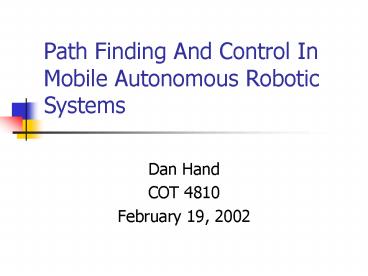Path Finding And Control In Mobile Autonomous Robotic Systems - PowerPoint PPT Presentation
Title:
Path Finding And Control In Mobile Autonomous Robotic Systems
Description:
Trial and Error. Pre Planning Adjustment (if needed) ... Pre-Planned Path. Trial & Error Path. Subsumption-Based Path-Finding ... – PowerPoint PPT presentation
Number of Views:384
Avg rating:3.0/5.0
Title: Path Finding And Control In Mobile Autonomous Robotic Systems
1
Path Finding And Control In Mobile Autonomous
Robotic Systems
- Dan Hand
- COT 4810
- February 19, 2002
2
Presentation Overview
- A robot is an computer-controlled
electro-mechanical device - Robotic systems can be grouped by movement
capability - Constrained systems
- Free moving systems, we will call these mobile
systems - Mobile robotic systems have some unique issues.
This presentation will focus on two - Path finding
- Related control issues
3
Path Finding
- Applies to autonomous systems
- Path Finding can consist of
- Trial and Error
- Pre Planning Adjustment (if needed)
- Several approaches have been used to implement
the intelligence in Path-Finding - Subsumption approach
- Knowledge-based approach
- Selection is dependent on information, sensors,
and computer hardware available
4
Path Finding Example
Consider the following situation
Straight Path
Trial Error Path
Target
Pre-Planned Path
Lake or Other Hazard
Robot
5
Subsumption-Based Path-Finding
- Corresponds roughly to a trial and error approach
- Approach to intelligence in robotic systems
- Proposed by R.A. Brooks in 1986
- Advocates building agents by combining simple
reflexive reactions - Characteristics
- No explicit knowledge representation
- Reflexive response to environment
- Purely reactive
- Behavior based systems extend subsumption
architecture to add state storage
6
Subsumption Architecture Example
- Behaviors can be viewed as being placed in a
stack - Behaviors with a lower precedence in the stack
are said to be suppressed - Avoidance behavior has highest precedence here
7
Subsumption Architecture Path Finding Example
Tree
Target
6
3
4
5
Initial Straight Line Course From Move To Target
Behavior
Path With Obstacle Avoidance Behavior
Robot
2
1
Building
- Active Behaviors At Each Point In The Diagram
- ) Default, Move To Target
- ) Default, Move To Target, Move Away From Hazards
- ) Default, Move To Target
- ) Default, Move To Target, Move Away From Hazards
- ) Default, Move To Target
- ) Default
8
Knowledge-Based Path-Finding
- Several knowledge-based mobile robots and
techniques exist - Basic idea
- If information about the environment is
well-known - Pre-planning a reasonable path based on known
data - Adjustments can be made (if needed) along the way
- If no or little information is available about
the environment - Possible to collect information and store along
the way - Problems arise with collecting accurate
information - Disadvantage
- System highly reliant on accurate and detailed
data on surroundings
9
Control Overview
- Control involves both sensing a condition and
taking a action based on it - Control difficulty dependent on complexity of
system hardware - Locomotion method
- Wheels / Tracks
- Legs
- Number type of sensors
- Vision?
- Operating environment issues
- Sensing environment, converting into useful
information - Localization
10
General Control Overview
- Feedback from output devices is critical in
mobile robotic systems to ensure operation in
varying environments
11
Feedback Example
- Consider the example below
- It is important to insure that each wheel spins
at the correct rate for the vehicle to remain on
course
Wheel
Sensor
Varying force applied to wheel
Top View
Motor Controller
Motor
Wheel Rotation
12
Localization
- Important control and sensing issue
- Consists of precisely locating position on map
- Needed to identify position relative to obstacles
- Especially important to knowledge-based systems
since error in positioning can accumulate - Numerous solutions exist
- High-accuracy GPS
- Landmark recognition
- Odometers
- Beacons
13
Localization Continued
- Sample situation with a standard GPS-Based system
Error in GPS Positioning
Distance to object
Object Detected By Sensors
14
Sample Knowledge-Based Robot
- TJ - Designed by Mark Torrance for his masters
thesis
Where are you? I don't know where I am right
now. Which way are you facing? I don't know
which way I am facing. Please tell me. You are
facing north I am facing NORTH. Thanks. You are
at Mark's office I'm learning about MARK'S
OFFICE. Turn around I'm turning around. Go
until you can turn right I'm going until I see no
obstacle on the right. You are at the northeast
entrance to the elevator lobby I'm learning about
THE NORTHEAST ENTRANCE TO THE ELEVATOR
LOBBY. Go I'm going. . . .
Designed to navigate around MIT offices Uses an
odometer for localization
15
For Additional Information
- Mobile Robots http//www.ai.mit.edu/projects/mob
ile-robots/http//www.cc.gatech.edu/ai/robot-lab/
- Subsumption Architecture http//ai.eecs.umich.ed
u/cogarch0/subsump/http//www-formal.stanford.edu
/eyal/lsa/ - Motor Control / Feedbackhttp//e-www.motorola.co
m/webapp/sps/site/homepage.jsp?nodeId03nQXG































